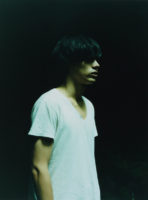It took me a while to warm up to Mayumi Hosokura‘s Kazan, because, I suppose, I had been too worried that someone was trying to sell me something. Images of youth, images of young, beautiful people aren’t hard to come by; our Western culture has embraced them (the images, not the people themselves) as something to be treasured. It’s easy to sell a pair of jeans when there’s a young, beautiful, seemingly carefree face and/or body next to them. And where no jeans are to be sold, where there’s “just” art photography, it’s the same promise that’s being sold, the promise of youth, of being able to (re-)connect with all that youth had to offer.
So I had to get that out of the way. I had to re-wire my brain a little bit. As it turns out, Hosokura provides a helping hand, since there are also other photographs in Kazan, showing minerals, say, or landscapes. If there are human figures in those landscapes, they don’t frolic in them. The subjects of Hosokura’s photographs are beautiful – in the sense that youth makes it easy to be beautiful, as are the minerals and the landscapes. They’re almost too beautiful.






The moment you realize something is too beautiful, a crack in the beauty emerges. You’ve just become a tad too conscious of what’s going on to continue admiring the beauty. Something is amiss. There’s a second thought, and a very similar thought (realization) emerges when dealing with youth as well: One day you’re young and beautiful, but the next day you’re not young any longer, and what happened to your beauty?
All the various dramas and problems we all encountered when we were young notwithstanding, we all fondly look back to when we were young. We’re nostalgic for our own past, an entirely imagined past. But still. We just never learned to let go, and to be more accepting of what we are and what we have – instead of what we possibly had or quite possibly (so we want to believe) might have. The grass does appear to be greener everywhere, in the past, in the future that we somehow have to work for, everywhere. How infuriating!
Photography manages to stop time, so the people and minerals and landscapes in Hosokura’s photographs will forever be beautiful, youthfully beautiful. But they could also serve as reminders that it is only the artifact photography that does this. Minerals, of course, might remain beautiful forever, but they have no soul. People, in contrast, age and lose their youthful beauty, but they have a soul. I suppose most of us can’t have both, beauty and a soul.
By stopping time, photography reminds us of what is gained from letting go. This is the hardest lesson to be learned when dealing with photographs: Looking at what was is never more than looking at what was. It often says precious little about what is, or what might be.
